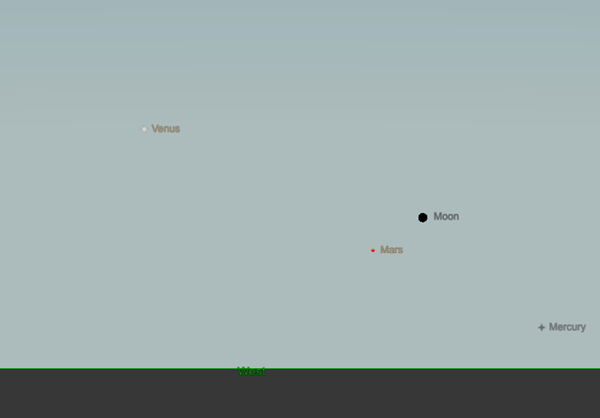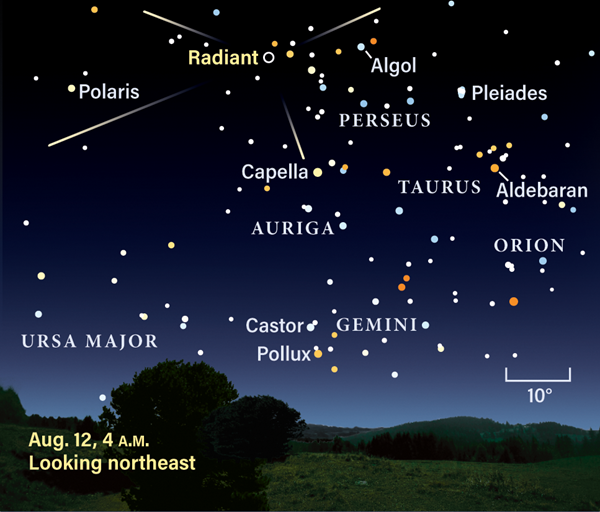Friday, August 6

Perseid meteors and stars: The photographer shot this unique image by combining several photos, leaving the stars in without affecting the look of the meteors.
Tonight, let’s try for an easy binocular object: the globular cluster M56, located in the constellation Lyra. This dense knot of stars sits about halfway from Sulafat (Gamma [γ] Lyrae) to Albireo, which denotes the head of Cygnus the Swan and lies to Gamma’s southeast. Both constellations will be high in the east by the time darkness falls, well out of the turbulent layer of atmosphere closest to the ground.
Through binoculars, M56 should be easy to spot with a magnitude of 8.3 and a span of 8.8'. M56’s core isn’t particularly bright and some may see it as a more uniform ball of fluff, but sharper-eyed or experienced observers may notice its denser core, which dissolves into a haze of stars at its edges.
While you’re in the area, go ahead and scan all the way to Albireo. This beautiful double star has components that appear yellow-orange and blue; they can typically be split by binoculars.
Sunrise: 6:03 A.M.
Sunset: 8:08 P.M.
Moonrise: 3:47 A.M.
Moonset: 7:23 P.M.
Moon Phase: Waning crescent (4%)
*Times for sunrise, sunset, moonrise, and moonset are given in local time from 40° N 90° W. The Moon’s illumination is given at 12 P.M. local time from the same location.
Saturday, August 7
If you’ve got a telescope and a hankering for a challenge, tonight is your night. It’s the perfect time to try for the Cat's Eye Nebula, also cataloged as NGC 6543. This planetary nebula — created when a Sun-like star sloughs off its outer layers as it ages — sits about one-third of the way between Polaris at the end of the Little Dipper’s handle and the head of Draco the Dragon. The nearest bright signpost is Zeta (ζ) Draconis, a 3rd-magnitude star about 5° west-northwest of the nebula, which is located in a relatively empty region of sky. This can actually make it a bit harder to find, so be patient and take your time.
The Cat’s Eye is small — only about 16" across — but this gives it a relatively high surface brightness that lets it be seen even with a small (4-inch) scope. But because it is so small, you’ll need to pump up the magnification to differentiate it from a star. This is where a larger telescope will help, and may even begin to show its complex shape and structure. In any scope, however, you may discern its blue-green color.
Sunrise: 6:04 A.M.
Sunset: 8:06 P.M.
Moonrise: 4:47 A.M.
Moonset: 8:04 P.M.
Moon Phase: Waning crescent (1%)
Sunday, August 8
New Moon occurs at this morning at 9:50 A.M. EDT, leaving a perfectly dark sky and excellent observing conditions. That’s good news, because there’s an event occurring tonight that you won’t want to miss.
Jupiter’s four Galilean moons — Io, Europa, Ganymede, and Callisto — circle the planet regularly, quickly changing positions over the course of a few hours. Sometimes, these moons cross in front of or fall into shadow behind Jupiter in transits and occultations. But special this year, thanks to the satellites’ orientation relative to our line of sight, are mutual events, in which the moons appear to eclipse or occult each other.
One such event occurs overnight tonight, as Ganymede’s large shadow crosses over Europa between 11:37 P.M. EDT and 12:44 A.M. EDT (on August 9). Turn a telescope toward the scene a bit early to find the two moons sitting west of Jupiter’s disk — Ganymede appears closer to the planet, with Europa farther out. Io (closest) and Callisto lie to Jupiter’s east.
Less than two hours later, the disk of Ganymede partially occults Europa as the two swap places between 2:17 A.M. and 2:46 A.M. EDT (again, on the 9th for those in the appropriate time zones).
Sunrise: 6:05 A.M.
Sunset: 8:05 P.M.
Moonrise: 5:52 A.M.
Moonset: 8:40 P.M.
Moon Phase: New
Monday, August 9

Twilight planets: This view shows the western horizon 15 minutes after sunset on August 9 from the U.S. Midwest. Visible alongside the crescent Moon are Mars and Venus; if your horizon is clear, pull out a pair of binoculars and look also for Mercury.
Mars is just a few months away from its conjunction with the Sun, making it progressively harder to observe. One of your last chances could be this evening, when a delicate Moon — just two days old — passes 4° north of the Red Planet at 9 P.M. EDT (note that the Sun may still be up at your location at this time).
Look for the pair shortly after sunset; they’ll be visible for about an hour after the Sun disappears, with red-hued Mars sitting 3.5° south-southeast of our satellite. Through a telescope, magnitude 1.8 Mars is just 4" across, thanks to its distance (2.6 times the average Earth-Sun separation) from our planet.
If you’ve got a clear western horizon and good conditions, you may be able to spot Mercury as well. It’s visible for about half an hour after sunset, hanging 9° west of the Moon and glowing a bright magnitude –1.1. Look for it with binoculars roughly 15 minutes after sunset, when it should be a mere 2° above the horizon.
Sunrise: 6:06 A.M.
Sunset: 8:04 P.M.
Moonrise: 6:59 A.M.
Moonset: 9:12 P.M.
Moon Phase: Waxing crescent (2%)
Tuesday, August 10
Comet hunters will want to get up early this morning to spot Comet 4P/Faye gliding less than 6° south of the Pleiades (M45) in Taurus. You’ll want to observe from a dark location with a 6-inch scope or larger to pick up faint fuzz of the comet, which should be around 11th or even 10th magnitude. If you have trouble spotting Faye at first, boost the power to 100x for a better chance at seeing it, then switch back to a lower power for a wider field of view.
Just a few miles wide, Faye was discovered in 1843. It returns every 7.6 years, but the view isn’t always ideal. In fact, the next time we’ll get a good look at this icy visitor is 2036.
Directly beneath the Pleiades — i.e., closer to the horizon — is bright red Aldebaran, the eye of the Bull. This aging star sits nestled among the scattered Hyades, an open star cluster like the Pleiades. The Hyades are closer and older than the Pleiades, both of which make its stars appear more spread out.
Sunrise: 6:07 A.M.
Sunset: 8:03 P.M.
Moonrise: 8:07 A.M.
Moonset: 9:40 P.M.
Moon Phase: Waxing crescent (5%)
Wednesday, August 11
Mercury passes 1.2° north of Regulus in Leo the Lion at 2 P.M. EDT. By 20 minutes after sunset, they are very low on the horizon (roughly 2° high) and the sky will be too bright to spot them without binoculars. Dedicated observers may catch a glimpse before they disappear below the horizon.
Much easier to view will be Venus and the Moon, which lie a bit higher in the west. Both are now in Virgo, with magnitude –4 Venus 11° high half an hour after sunset and sitting 8° west of the Moon. The Moon passed 4° north of the planet earlier this morning at 3 A.M. EDT, when both were hidden below the horizon. The thin waxing crescent Moon may show some earthshine, which occurs when sunlight reflecting off Earth illuminates the portion of our satellite in shadow.
Sunrise: 6:08 A.M.
Sunset: 8:02 P.M.
Moonrise: 9:16 A.M.
Moonset: 10:07 P.M.
Moon Phase: Waxing crescent (11%)
The Perseids' radiant at peak in 2021
Thursday, August 12

Perseid meteor shower: Many bright Perseids leave a fluorescent trail called a persistent train. Longer streaks typically lie some distance from the radiant, so center your view 40° to 60° away from this point.
The well-known Perseid meteor shower peaks today. This show has something for everyone: Eager observers can watch for shower meteors either early in the morning before sunrise or late at night after moonset. The Perseids are frequently ranked one of the best showers of the year and are expected to produce up to 110 meters/hour under prime conditions (when the radiant reaches 90° in altitude).
Perseus sits high in the east before sunrise, offering the greatest likelihood of seeing plentiful meteors. The radiant, which sits 2.5° northeast of magnitude 3.8 Miram, reaches 60° in altitude in the hour before dawn, which attenuates the expected number of meteors per hour by about 15 percent. Looking slightly away — about 40° to 60° — from the radiant increases your chances of catching bright meteors with long trains. Some may even leave smoke trails that can persist in the sky for minutes after the bright flash.
If you’re opting for evening meteor hunting, wait until after moonset (around 10:30 P.M. local time). At that time, the radiant is nearly 20° high and climbing, leaving the rest of the night to search out bright streaks.
Most meteors burn up between about 50 and 70 miles (85 and 115 kilometers) in altitude, and no meteor showers come from particles big enough to leave anything behind to reach the ground (known as a meteorite).
Sunrise: 6:09 A.M.
Sunset: 8:00 P.M.
Moonrise: 10:24 A.M.
Moonset: 10:33 P.M.
Moon Phase: Waxing crescent (19%)
Friday, August 13
Brilliant Venus sits just 8' from magnitude 3.6 Beta (β) Virginis this evening. It looks almost as if the bright planet, which blazes at magnitude –4, has a dimmer moon of its own. You can begin looking for the pair soon after the Sun sets; binoculars should be enough to pick up the dim star in the darkening sky. An hour after sunset, they’re just 5° high, and the pair sets around 9:30 P.M. local time.
A telescope will better reveal Venus’ 14"-wide disk, which appears 78 percent lit. Twilight is the best time to enjoy this evening star, when the brighter sky lets you better examine it. (Always take care to never use binoculars or a telescope until after the Sun is no longer in the sky.) That’s because in a darker sky, the planet’s sheer brightness makes it more difficult to make out details or clearly see the phase.
Venus will continue to move east through Virgo as the month progresses, passing near Porrima (Gamma Virginis) on the 23rd and ending August less than 6° from bright Spica, the Maiden’s alpha star.
Sunrise: 6:10 A.M.
Sunset: 7:59 P.M.
Moonrise: 11:35 A.M.
Moonset: 11:00 P.M.
Moon Phase: Waxing crescent (29%)
Source: Astronomy Magazine